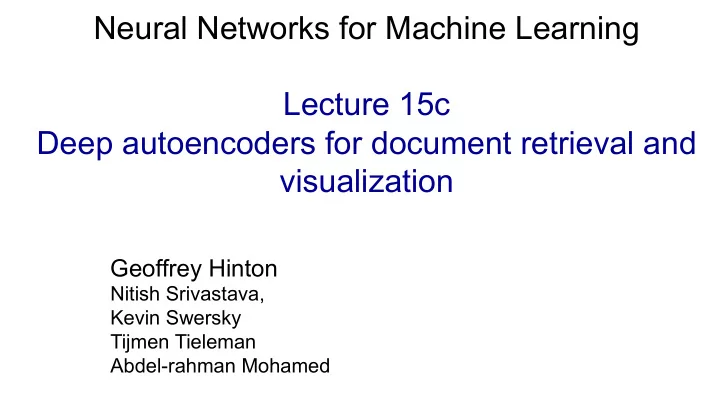

Neural Networks for Machine Learning Lecture 15c Deep autoencoders for document retrieval and visualization Geoffrey Hinton Nitish Srivastava, Kevin Swersky Tijmen Tieleman Abdel-rahman Mohamed
How to find documents that are similar to a query document fish 0 • Convert each document into a � bag of words � . cheese 0 – This is a vector of word counts ignoring order. vector 2 count 2 – Ignore stop words (like � the � or � over � ) school 0 • We could compare the word counts of the query query 2 document and millions of other documents but this reduce 1 is too slow. bag 1 – So we reduce each query vector to a much pulpit 0 smaller vector that still contains most of the iraq 0 information about the content of the document. word 2
How to compress the count vector output 2000 reconstructed counts vector • We train the neural network to 500 neurons reproduce its input vector as its output 250 neurons • This forces it to compress as much information as possible 10 into the 10 numbers in the central bottleneck. 250 neurons • These 10 numbers are then a good way to compare 500 neurons documents. input 2000 word counts vector
The non-linearity used for reconstructing bags of words • Divide the counts in a bag of words • When we train the first vector by N, where N is the total number RBM in the stack we use of non-stop words in the document. the same trick. – The resulting probability vector gives – We treat the word the probability of getting a particular counts as probabilities, word if we pick a non-stop word at but we make the visible random from the document. to hidden weights N times bigger than the • At the output of the autoencoder, we use hidden to visible a softmax. because we have N – The probability vector defines the observations from the desired outputs of the softmax. probability distribution.
Performance of the autoencoder at document retrieval • Train on bags of 2000 words for 400,000 training cases of business documents. – First train a stack of RBM � s. Then fine-tune with backprop. • Test on a separate 400,000 documents. – Pick one test document as a query. Rank order all the other test documents by using the cosine of the angle between codes. – Repeat this using each of the 400,000 test documents as the query (requires 0.16 trillion comparisons). • Plot the number of retrieved documents against the proportion that are in the same hand-labeled class as the query document. Compare with LSA (a version of PCA).
Retrieval performance on 400,000 Reuters business news stories
First compress all documents to 2 numbers using PCA on log(1+count). Then use different colors for different categories.
First compress all documents to 2 numbers using deep auto. Then use different colors for different document categories
Neural Networks for Machine Learning Lecture 15d Semantic hashing Geoffrey Hinton Nitish Srivastava, Kevin Swersky Tijmen Tieleman Abdel-rahman Mohamed
Finding binary codes for documents 2000 reconstructed counts • Train an auto-encoder using 30 logistic units for the code layer. 500 neurons • During the fine-tuning stage, add noise to the inputs to the code units. 250 neurons – The noise forces their activities to become bimodal in order to resist code 30 the effects of the noise. – Then we simply threshold the 250 neurons activities of the 30 code units to get a binary code. 500 neurons • Krizhevsky discovered later that its easier to just use binary stochastic 2000 word counts units in the code layer during training.
Using a deep autoencoder as a hash-function for finding approximate matches supermarket search hash function
Recommend
More recommend